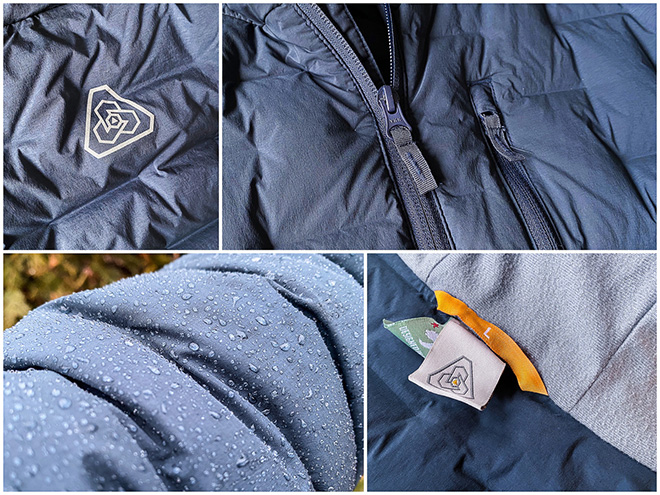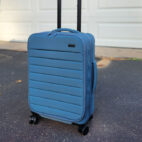

I’ve got years of experience with down hoodies under my belt. Patagonia, Arc’teryx, Rab, Fjӓllrӓven… even some other PDW down jackets (Kepler and Tycho). But the Prometheus Design Werx Stratus Down Hoodie might be my favorite lightweight down hooded jacket to date.
Not all down jackets are made equally. Most of them have stitched-through down pockets, which is the easiest construction. But that also creates thermal bridges on the stitching lines, which transfer body heat to the cold outside. Sure, it’s not a rapid process so such jackets still work. But there are also more advanced methods of arranging down pockets that eliminate this problem. And that’s the first big advantage of the Stratus Down Hoodie; with stitch-less baffle construction it’s truly effective at keeping your body warm without conducting warmth to the outside.

Materials
The outer material is 20D Stretch Nylon, which is a standard thickness in high-quality packable down jackets. It’s a good compromise between being lightweight and durable enough for daily use (also as an outer piece). The Stratus is available in two colors – light gray (Mission Gray) and dark blue-gray called Outpost Blue (reviewed). Generally gray is good – it’s like a chameleon and blends well with almost any other color, so can be used for many outfits… if you care for color matching, of course. Prometheus also gave it an attractive matte finish, without that common shiny polyester look (which might have been cool in the ’70s).

The Stratus is filled with top-tier goose down – 800 fill power, RDS certified, with a Dupont DWR finish, and with additional antimicrobial treatment for long-lasting odor-free use. In plain English: it can be used for a long time without washing, and also in humid conditions that would certainly kill the insulative properties of a standard untreated down. The outer fabric is DWR coated too, so it works fine for basic snow and drizzle protection. But always have your hardshell ready in your pack for really bad conditions.

The lining in the Stratus is quite special too. Most down jackets are fully lined with nylon, which can be very cold on first contact; especially on the neck and face. Prometheus upgraded the lining in critical areas (neck, hood) with a soft and cozy tricot. Imagine yourself in -15 degrees Celsius outside… the practical difference of nylon versus tricot on your skin would be more than noticeable. Also, the side pockets are similarly finished inside, so the warming effect starts instantly when you fit your hands into them.

Fit, trim, and length
The anatomical cut requires more advanced body mapping at the design stage, so not all jackets feature this kind of trim. Straight and boxy down jackets are way more popular. And they are fine… for urban use (at best). But they are not even close to the thermal efficiency required for a serious outdoor adventure.
Less space between body and jacket means less air to trap and heat; that’s why down hoodies should be as close to the body as possible. Also, an anatomical fit means less material, so less bulk, and less weight. Respected outdoor companies make outdoor jackets that way, and PDW is no exception here. The Stratus hugs around your body and follows the natural shape of a human’s torso, back, and lumbar area.
The hood is quite snug too, with a front high collar protecting the throat area. There are no additional cinch cords in the hood – with this kind of precise design such a feature is simply not required. However, you’ll find a cinch shock cord at the bottom of the jacket (otherwise body heat would easily escape there).

The Stratus isn’t a long piece, so it doesn’t restrict movement and can be worn for a variety of activities. Not just walking a dog or winter hiking, but also mountaineering, and even when skiing during really frosty days or belaying on a multi-pitch route. It’s slightly longer on the back too, so keeps the kidneys well protected during dynamic movements and bending. Thanks to that longer back area it works fine for backpacking too, even in sub-zero temperatures. The sleeves are lightly articulated, with elastic cuffs, and are long enough even for my rather longish arms.

Layering
The Stratus’s response is springy, puffy, but it’s not too thick. It’s designed to be worn on its own as an outer piece (I use it like that most of the time actually) but can also be used as an insulating layer. I can fit two layers under it: merino base and power stretch fleece or light wool pullover. And you could easily put any winter hardshell over the Stratus, which is mandatory functionality for an active mountaineering down jacket. The last thing I’d like up there on the ridge would be a super-puffy parka, without any chance to cover it with a hardshell when an icy blizzard hits at full throttle.

Extra features
First of all, you’ve got all the pockets you could ever wish for in a down hoodie. Side hand-warmer pockets (tricot-lined, so really warm for your hands as I mentioned), one Napoleon pocket, and another chest pocket inside. Both chest pockets are tailored with down on the outside, so whatever you put in there is going to stay warm: mobile, camera batteries, GPS. And that’s exactly what you want. The right-hand pocket features a comm cable pass-through, which is a golden standard in outdoor jackets these days. PDW uses a #5 two-way main zipper and #3 pocket zippers – all are YKK reverse coil nylon zips. The front zipper is additionally protected with a wind flap underneath for added thermal protection.

Packability
There are three ways to pack this thing. One – just roll it and stuff it into the hood. I like to do just that as it’s really super fast and doesn’t compress down too much. If you want to save some space in a pack just stuff it “into the pocket” and you’ll get a package that is about 40-50% smaller in size. Sure, it takes slightly more time and effort to compress it like that, and also after unpacking you should give it some time to rest – about 30 seconds so the down can fully expand. So for a quick on/off action, it’s not as good as just rolling into the hood. But it saves space. Decisions, decisions…
When stuffed inside its pocket, the Stratus Down Hoodie doesn’t eat too much space. To compress it even more you could use a dedicated compression sack. But it’d require even more time to get it back to “full puffiness” (and waiting is not always an option when you’re exposed outside). Last but not least – you can use the supplied travel pillow sack, which transforms the Stratus into a horseshoe-shaped neck pillow. It’s ingenious and super comfy during long-haul traveling by air or bus.

Real use and conclusions
I’ve been using the Stratus Down Hoodie for almost two months now, in various weather conditions. At anything between +5 and -15 degrees Celsius, in drizzle and during snowfalls too. Plus some daily city cruising. Actually, I almost live in my Stratus this winter when I’m outside – it’s just so good and comfortable. With the DWR treated outer material and special hydrophobic down it handled all weather situations with flying colors. Not just when walking a dog (that too naturally) but mostly in the backcountry and mountains, when I was testing packs for the Carryology 2021 Awards… and not one or two but all ten of them to be exact (yes, ten!).

Consider these ten packs – all sizes and weights between 18L and 55L, so I can tell a thing or two about the Stratus’s durability too now. So far it’s held up great, without any issue regarding fabric or stitching. Not a single hole or tear, except for some dirt here and there and some light marks on the cuffs. It still does look practically like on day one. Undoubtedly it’s going to be my most used down garment; not only as an outer layer but also as insulation, as the Stratus fits great in my layering system.
Outsourcing the stitching process to an overseas facility helped PDW to keep the price at $289, which is not cheap, but still a competitive price among other top-tier down hoodies on the market. Patrick Ma, gear designer and mastermind behind Prometheus Design Werx, put into this project all his knowledge and experience, plus modern materials and top technologies. I can recommend the Stratus to any outdoorsmen and adventurers without a doubt as a very versatile active down hoodie. Rest assured that the Stratus Down Hoodie will serve you well for many missions and in multiple scenarios.






 Carry Awards
Carry Awards Insights
Insights Liking
Liking Projects
Projects Interviews
Interviews








